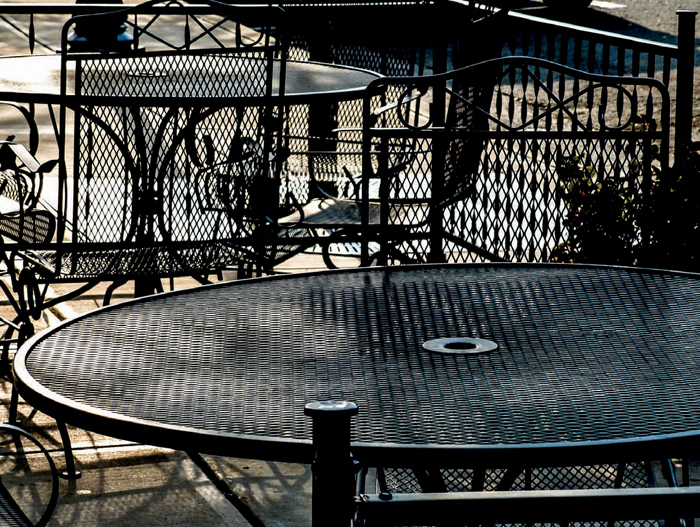Harsh Light, Soft Light, and Shadows
Some people have an instinctive grasp of lighting and how all of the different elements of this vast subject come together, but most of us need a little help. Here are two statements to get the ball rolling:
1. The closer the light source is to the subject, the softer the shadows
2. The bigger the light source, the softer the shadows
The harshness or softness of the light depends on the size of the light source in relationship to the object being photographed.
I recommend testing these statements before going on, and to do so, I suggest doing a few exercises that may seem like simplistic and possibly even insulting suggestions to aid understanding, but please try the exercises and experiment with them. Try to get interesting photographs because this will make the whole exercise more enjoyable. Understanding something in the abstract is of limited use. It is when the lesson is applied that real learning takes place.
First, find a desk lamp and an object, such as a toy or a ball. Make sure the desk lamp is the only light source, and draw the blinds or curtains. Place the object close to the lamplight and take a photo of the object and the shadow it casts. Move the light farther away and take another photo from the same position. This will force an understanding of the previous two statements about light sources.
Second, get a piece of parchment paper or a piece of semitransparent plastic, place it between the desk lamp and your object, and take a picture of the object. Now move the paper different distances from the light and take more pictures. You should see the shadow getting softer and its edges getting more blurred as you move the paper—which acts as a diffuser—farther away from the light and closer to the object.
The take-home message here is that the softness of the light (which we see by looking at shadows) depends on the size of the light source in relationship to the object being photographed. Moving the light source closer or placing a diffuser in front of the light increases its size, making for softer light. Moving the light source farther away makes it harsher.
Let’s apply this to photography in the real world. The sun is a large object, but it is a long way away. This distance means that the sun is a small light source. This is why photographing in direct sunlight—other than in the early morning and late evening—produces harsh shadows and extreme contrasts that are way beyond what most camera sensors can capture. Shortly I will return to why this is different when the sun is low in the sky.
Now, let’s consider clouds. You may have already worked out that clouds serve exactly the same function as the parchment paper or plastic diffuser that we used in the desk lamp experiments. The cloud cover works like a huge diffuser, in effect increasing the size of the light source many times, thereby giving a much softer light. The most even natural light is found on a foggy day, where we are essentially working inside a cloud. I love shooting in fog because it adds a sense of mystery to a photo, and it is nature’s way of removing background clutter. The reason that light is softer at dawn and dusk is that it has to travel through much more of the earth’s atmosphere than it does at midday, and thus the atmosphere can be thought of as a very diluted cloud.
Let’s see how this applies to lighting provided by a photographer. The standard-issue flash on a point-and-shoot camera is all but unusable because it is tiny and not diffused. It is also all but unusable for several other reasons, including close proximity to the lens and a lack of power, but those are subjects for another time. The best advice I can give regarding the use of on-camera point-and-shoot flashes is this: don’t.
The bigger strobe units on DSLRs are a bit better because the area that the light comes from is larger, yet it is still too small to give soft light. The strobe lights are more powerful than the built-in compact camera flash units and, even on the camera hot shoe, are farther away from the lens. The flash can be used off-camera by means of either remote control or cable, which is the best option by far. Unless a hard light is desired, a strobe light usually needs some help. You can fit a diffuser over the top of the flash or bounce the light off of a white ceiling or wall. Either of these methods works well. Bounce flash changes the quality of light, though, because the relatively small surface of the light is greatly increased.

A window provides light for this shot. The combination of indirect light and a high aperture setting gives this image its softness.
A good photograph does not depend on soft light. Some of the most striking photographs come from the use of harsh direct sunlight and the corresponding hard, well-defined shadows. Many photographers treat shadows as something that should be minimized at all costs. It is much more productive to treat shadows as something to be embraced, something that can add tremendous impact to an image. We are wired to exist in a three-dimensional world, so our brains treat shadows as very much a secondary, unimportant thing. The best visual artists and photographers understand this and can elevate shadows to be at least as striking as the objects that cast them.
For a practical demonstration, find a room with venetian-type blinds and direct sunlight. Set the meter on your camera to spot metering and expose for a shadow cast by the blind. Now take a picture. It may not be the best photograph ever, but it will be striking, and you may just be surprised by people’s reaction to it. We are wired, as a species, to be more responsive to contrast than any other visual element.

Soft morning light. This image was taken around 8:00 a.m. After this time the light gets harsh very quickly.
I am not arguing against using the soft, warm light of dawn, but rather that you at least experiment with other types of light. It is important to know the more traditional theory of lighting because it will enable you to take a magazine-quality portrait or a perfect product shot. The ideal is both to know this and to be prepared to discover something new. The best results often come when our experimentation can be incorporated into more traditional methods. This synthesis produces images that are different enough to get someone’s attention, but not so different as to appear gimmicky, which has limited appeal.
